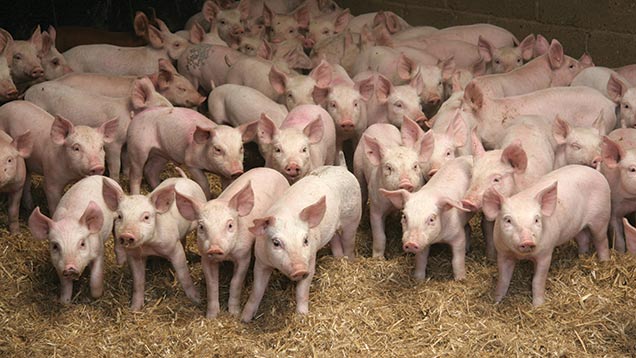Advice on preventing and tackling PEDv on farm
 © Tim Scrivener
© Tim Scrivener Pig producers are being urged to prepare themselves against the high threat of an outbreak of Porcine Epidemic Diarrhoea virus with the help of specialist guides.
Twelve standard operating procedures (SOPs) have been produced by Bpex on behalf of the cross-industry alliance Pig Health and Welfare Council, giving farmers advice on biosecurity.
It follows confirmation of the US virulent strain in the Ukraine and the high mortality seen in piglets (70-80%) from the low virulent strain in Germany last autumn.
See also: Latest pig industry news
The guides detail steps that must be taken in the event of an outbreak and are based on experiences of the Canadian industry, which had some success in controlling the disease, says Bpex vet manager Martin Smith.
“Their main purpose is to detail what actions each area of the industry needs to take and when,” Mr Smith explains.
“The dozen SOPs will cover dealing with visitors on site and vehicles, plus one about manure and another dealing with how fallen stock should be handled.”
The guides apply to all producers, processors and the entire allied industry.
Notification system
Another tool to tackle PEDv, which is expected to launch in the UK in the next few days, is a notification system. The Significant Disease Charter will require producers and their vets to voluntarily sign up to agree to share data on suspected PEDv outbreaks.
“Farmers must be willing for the first part of their postcode to be shared within a three-mile radius should an outbreak occur. Any linked holdings will also be notified,” says Mr Smith.
The notification system is designed to give others in the area the best chance to improve biosecurity.
“Ultimately we are trying to encourage the industry to take responsibility. We are aware we could see the same 10% drop in production as seen in the US, with a concurrent 10% rise in the pork price due to lack of supply, which would have a significant impact on the UK pig industry.”
Mr Smith says strict biosecurity is a key tool in the armoury against PEDv as it is the only thing that seemed to prevent the spread of PEDv in Canada.
“It is like paying in money to an insurance policy, you don’t see the benefits of practising good biosecurity until you need it.
“And being prepared from the start is exactly how Canada was able to keep on top of the disease, so we have based our guides on the Canadian model,” he adds.
Top tips for preventing and tackling PEDv on farm
- Use barriers to limit disease spread, for example no entry signs, fences and gates plus clearly marked lines to prevent uncontaminated objects or people mixing with potentially contaminated ones.
- Thoroughly clean and disinfect to kill pathogens using these four steps:
- Remove organic matter with detergent
- Wash thoroughly
- Disinfect with the correct product and concentration
- Give surfaces time to dry
- Prevent all unnecessary visits to the farm and keep records of all movements on and off the farm in case of an outbreak, to determine source and transmission route.
- Ensure all visitor and staff vehicles are parked outside the unit perimeter, preferably on well-drained hard standing, and are free of organic material.
- Source incoming pigs and supplies carefully – if you are not satisfied you have the right to refuse entry.
- Organise the movement of people, pigs and equipment to keep disease confined, working from least to most infected areas.
- When loading pigs have all equipment ready and do not cross the marked line preventing uncontaminated and potentially contaminated objects or people mixing.
- Farm staff must be aware of and minimise the risks they pose, for example no contact with pigs or pig manure outside of employment; arriving clean and in clothes not exposed to their own livestock; and wearing outerwear and boots provided (which must be left on farm) and not bringing any pigmeat products on to the farm.
- If you are diagnosed as PEDv positive stop all movements to and from the farm and contact the BPEX PEDv Control Centre, which will go live in the event of an outbreak.
- Movements from PEDv infected sites require co-ordination between the Control Centre, farmer, haulier and destination (abattoir or farm only). Any vehicles and people involved are classed as high risk and require intensive cleaning and disinfection.

